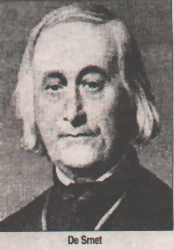
Taken from The Daily Nonpareil‘s “Celebration 150,” written by Katharine Carlon
Father Pierre-Jean De Smet was sent to Council Bluffs to “civilize and Christianize” its Native American residents, but it was his own civility and Christian generosity that made him one of the most famous figures on the western frontier.
The man who would become known as “the spiritual Christopher Columbus of the West” began his great missionary career in present-day Council Bluffs when the Jesuit fathers of St. Louis asked him to establish the first Christian church and school in the upper Missouri valley.
De Smet, then 37 years old, arrived by steamship on the banks of Lake Manawa – at that time a channel of the Missouri River – on May 31, 1838, along with another Jesuit priest, Father Felix Verreydt, and Brother Andrew Mazzella. When the men debarked, they found nearly 20,000 Pottawattamie Indians waiting for them at the boat landing.
According to Francis Cassilly, a Creighton University scholar who wrote about the life of De Smet in 1917, “their welcome was cold with only two coming forward to shake hands.”
Luckily, Chief Billy Caldwell, the half Irish-half Pottawattamie Indian who had served as an assistant to Tecumseh, stepped forward to offer the men the use of three cabins located near his camp, four miles to the north.
De Smet and his men accepted the invitation and were given the building that would become St. Joseph Mission – a blockhouse originally built as a point of defense against the Sioux, who resented the 1837 treaty that brought 3,000 Pottawattamies from Indiana and Illinois to what would become western Iowa. The new mission was located near the present-day corner of Pierce and Union Streets.
In a letter dated July 20, 1838, De Smet described their meager accommodations: “We have a fine little chapel, 24 feet square, surmounted by a little belfry; four poor little cabins beside, made of rough logs, they are 14 feet each way with roofs of rude rafters which protect us from neither rain nor hail, and still less from snow of winter.” Still, De Smet’s school quickly filled with a capacity enrollment of 30 boys.
The missionaries “had good success for a time in putting a semblance of Christianity into this wild frontier post,” Cassilly said. Hundreds of conversions and baptisms were recorded in the mission’s short history.
But the founders of Council Bluffs’ first church also faced trouble from the Sioux. De Smet twice visited Sioux leaders to help restore peace.
De Smet’s service in Council Bluffs ended in fall 1839 when he was transferred to the far northwest, but several Jesuits stayed behind and he made a return visist later that year.
In a letter, De Smet wrote of his sad homecoming: “I had, however, the grief of observing the ravages which unprincipled men, liquor sellers, had caused this budding mission. Drunkenness with the invasion of the Sioux on the other hand, had finally dispersed my poor savages.”
Horrified by what he had seen during his Council Bluffs visit, De Smet wrote a stirring letter to federal authorities describing the terrible effects of “whiskey on the red man” and protesting the government’s failure to solve the problem. De Smet’s concerns were ignored for decades, but he went on to champion the cause of Native American welfare.
His understanding and appreciation of the plight of the American Indian meant that the U.S. government often used him to negotiate with tribal leaders angered by the coming of white settlers. In 1868, five years before his death, De Smet negotiated a temporary peace with Chief Sitting Bull, whose Sioux warriors had vowed to kill the next white man they saw.
De Smet’s Council Bluffs mission lasted only two years. Under constant threat of Sioux attacks, most of the Pottawattamies moved south of Fort Leavenworth, Kansas in 1841 and the facility’s last resident missionary left the area in August 1841.
According to Cassilly, “time and time again De Smet was called upon by army officers, Indian agents and the President himself to help straighten out the Indian tangles and wars into which the government so often blundered.”
